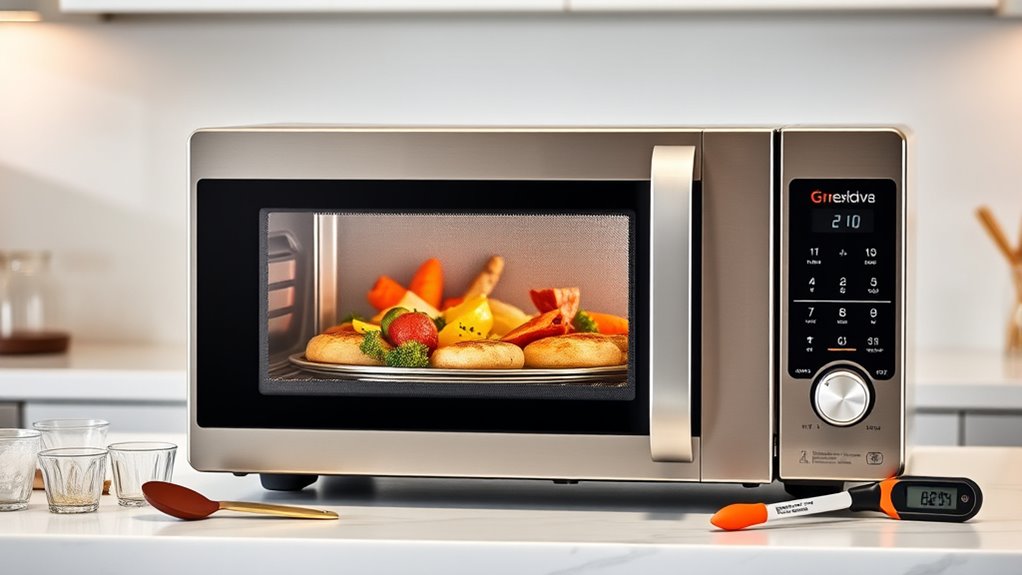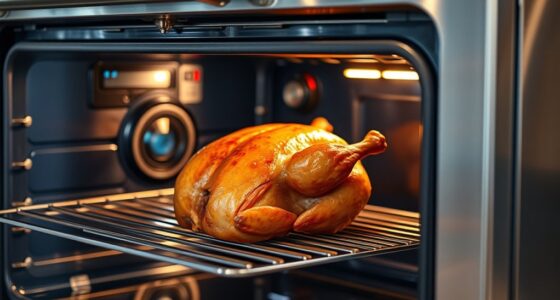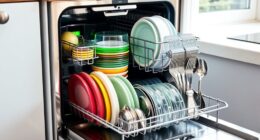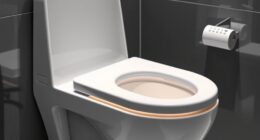To use a convection microwave oven, start by reading your model’s manual for specific instructions on rack placement and cooking times. Preheat the oven if needed, especially for browning, and use suitable cookware like glass or ceramic. Arrange food in a single layer for even cooking, and adjust the time and temperature based on what you’re preparing. Regular cleaning and maintenance will keep your oven working efficiently, and if you continue exploring, you’ll discover more helpful tips.
Key Takeaways
- Preheat the convection microwave by setting the desired temperature and allowing it to warm up before cooking.
- Use appropriate cookware like glass or ceramic and place the food in a single layer for even cooking.
- Select the convection mode, set the temperature, and adjust the cooking time according to your recipe.
- Arrange racks as specified in the user manual for optimal heat distribution and browning.
- Always monitor cooking progress and clean the interior and accessories regularly for maintenance and safety.
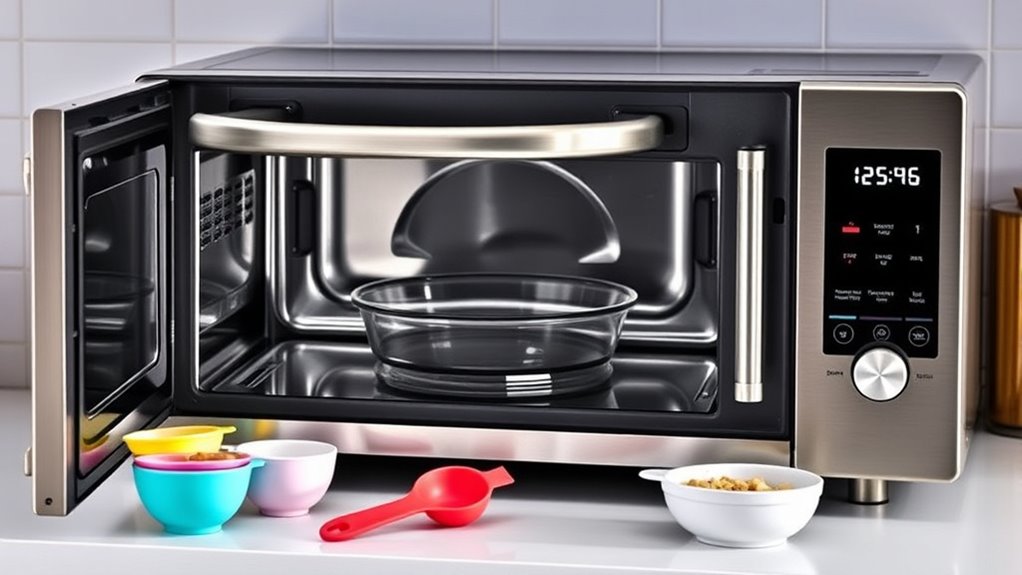
Have you ever wondered how to make the most of your convection microwave oven? Whether you’re new to this versatile appliance or just looking to improve your skills, understanding some essential tips can help you maximize its potential. First, mastering cooking tips is key to achieving perfect results. Since convection microwave ovens combine microwave power with convection heat, you can bake, roast, or simply reheat food with ease. To start, always read your user manual carefully; it provides specific instructions for your model, including recommended rack placements and cooking times. When preparing food, remember that convection cooking often requires lower temperatures and shorter times than traditional ovens. Preheating the oven can improve browning and even cooking, so don’t skip this step. Use the right cookware—microwave-safe glass, ceramic, or metal pans designed for convection baking—to guarantee even heat distribution. For best results, try to arrange food in a single layer to promote uniform cooking and avoid overcrowding, which can lead to uneven results.
In addition to cooking tips, maintenance guidance plays a crucial role in keeping your convection microwave oven functioning efficiently. Regularly clean the interior and exterior surfaces with a damp cloth to remove grease and food splatters. For stubborn stains or burnt-on residues, use a mild detergent or a mixture of vinegar and water. Avoid abrasive scrubbers that could scratch the surface. Remember to clean the turntable and replace it if it becomes damaged. Checking the door seal periodically ensures that the microwave maintains proper heat and prevents energy loss. If you notice any unusual noises or if the oven isn’t heating properly, consult your manual or contact a professional technician for servicing. Proper maintenance extends the lifespan of your appliance and keeps it operating safely.
Additionally, periodically inspecting the microwave’s vents and filters helps prevent overheating and ensures efficient airflow. Don’t forget to unplug the oven before performing any cleaning or maintenance tasks to avoid accidents. Keeping the control panel free of dust and grime also helps maintain its responsiveness. When not in use for an extended period, unplug the appliance and store it in a dry, clean location. Following these simple maintenance guidelines will ensure your convection microwave oven remains a reliable helper in your kitchen for years to come. With a combination of proper cooking techniques and diligent upkeep, you’ll enjoy delicious meals and hassle-free operation from this versatile appliance.
Frequently Asked Questions
Can Convection Microwave Ovens Replace Traditional Ovens Entirely?
Convection microwave ovens can’t fully replace traditional ovens because they offer limited cooking versatility compared to larger, specialized appliances. While they excel at quick reheating, baking, and grilling, they may struggle with large or complex dishes. However, their compact size allows for easy appliance integration in your kitchen. You’ll find them perfect for everyday tasks, but for full-scale baking or roasting, sticking with a traditional oven is still your best bet.
What Are the Best Cookware Materials for Convection Microwave Baking?
Choosing the right cookware for convection microwave baking is like selecting a trusted friend. You want materials with good heat conductivity and compatibility, such as glass, ceramic, or microwave-safe metal. These materials heat evenly and work well with your oven’s features. Avoid plastics or non-microwave-safe metals, which can cause uneven cooking or safety issues. So, pick cookware that distributes heat evenly for perfect baking results every time.
How Do I Clean and Maintain My Convection Microwave Oven?
To clean your convection microwave oven, follow simple cleaning tips like wiping down the interior with a damp cloth and using a mild detergent. Regular maintenance routines include cleaning the turntable, checking the door seal, and avoiding abrasive cleaners. Make sure to unplug it before cleaning, and keep vents clear for proper airflow. Doing this regularly helps your oven operate efficiently and extends its lifespan.
Are Convection Microwave Ovens Energy-Efficient Compared to Conventional Ovens?
Sure, convection microwave ovens are more energy-efficient than conventional ovens, right? They use less energy consumption because they cook faster and heat more evenly, reducing your environmental impact. So, while it may seem like a small thing, choosing a convection microwave helps save energy and the planet, all while making your cooking quicker. Who knew that saving the environment could start with a simple switch in your kitchen?
What Safety Precautions Should I Follow When Using a Convection Microwave?
When using a convection microwave, you should always prioritize food safety and proper appliance handling. Keep the door sealed tightly during operation to prevent radiation leaks, and avoid metal objects inside. Use oven mitts to handle hot containers, and never operate the microwave when the door is damaged. Regularly clean the interior to prevent bacteria buildup, and follow manufacturer instructions to guarantee safe, efficient use of your appliance.
Conclusion
Now that you know how to operate your convection microwave oven, you’ll find it’s like a secret garden where recipes come to life. As you open the door, imagine the aroma of perfectly baked cookies wafting out, just like a surprise waiting to be discovered. With a little practice, you’ll effortlessly switch between functions, turning everyday cooking into a delightful dance. It’s amazing how a simple appliance can transform your kitchen into a place of endless possibilities.
